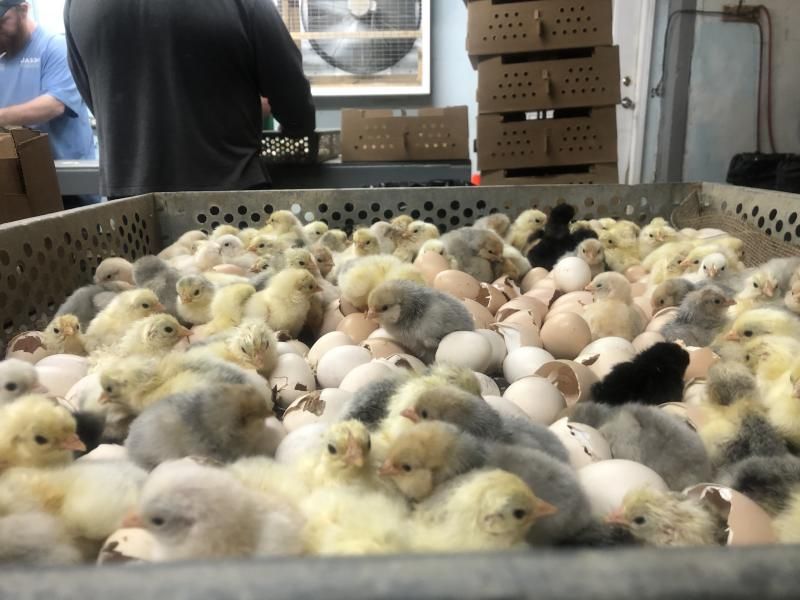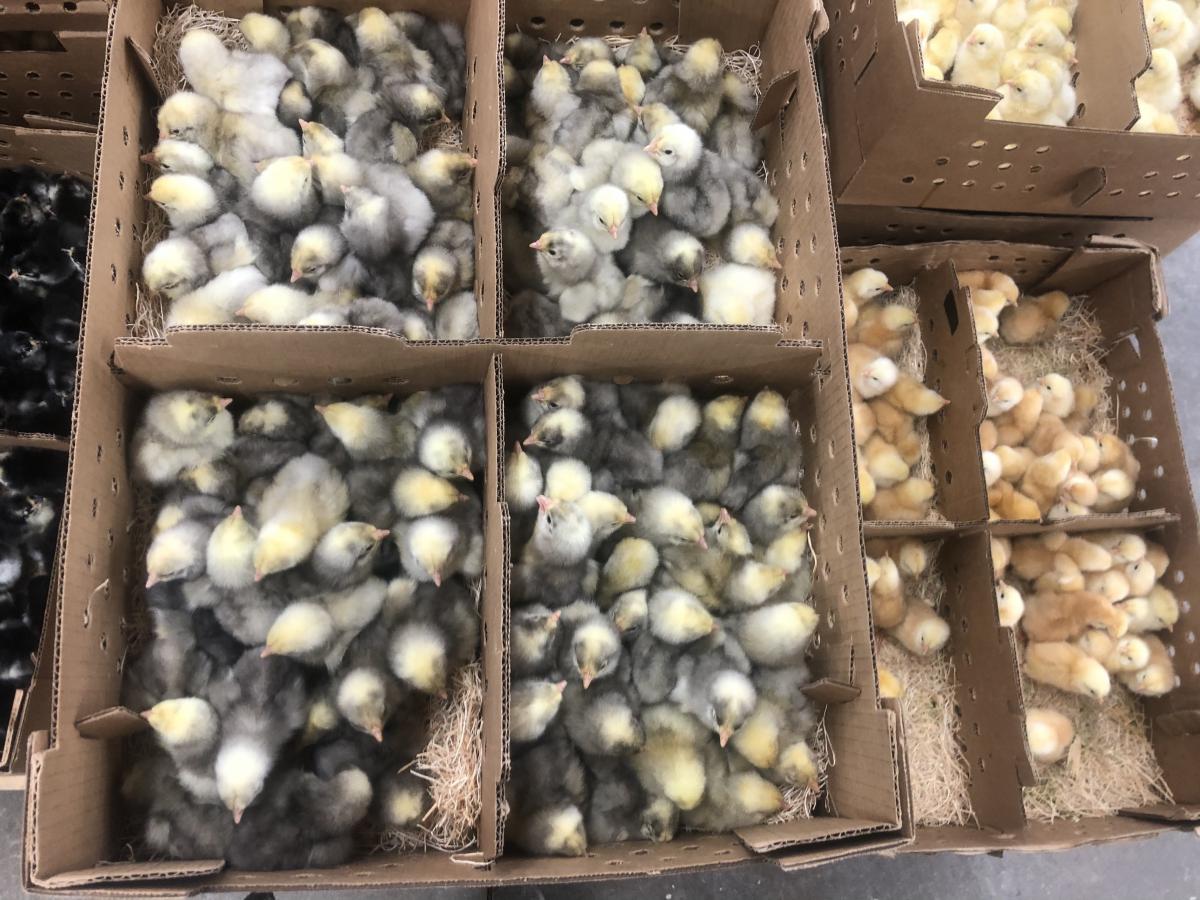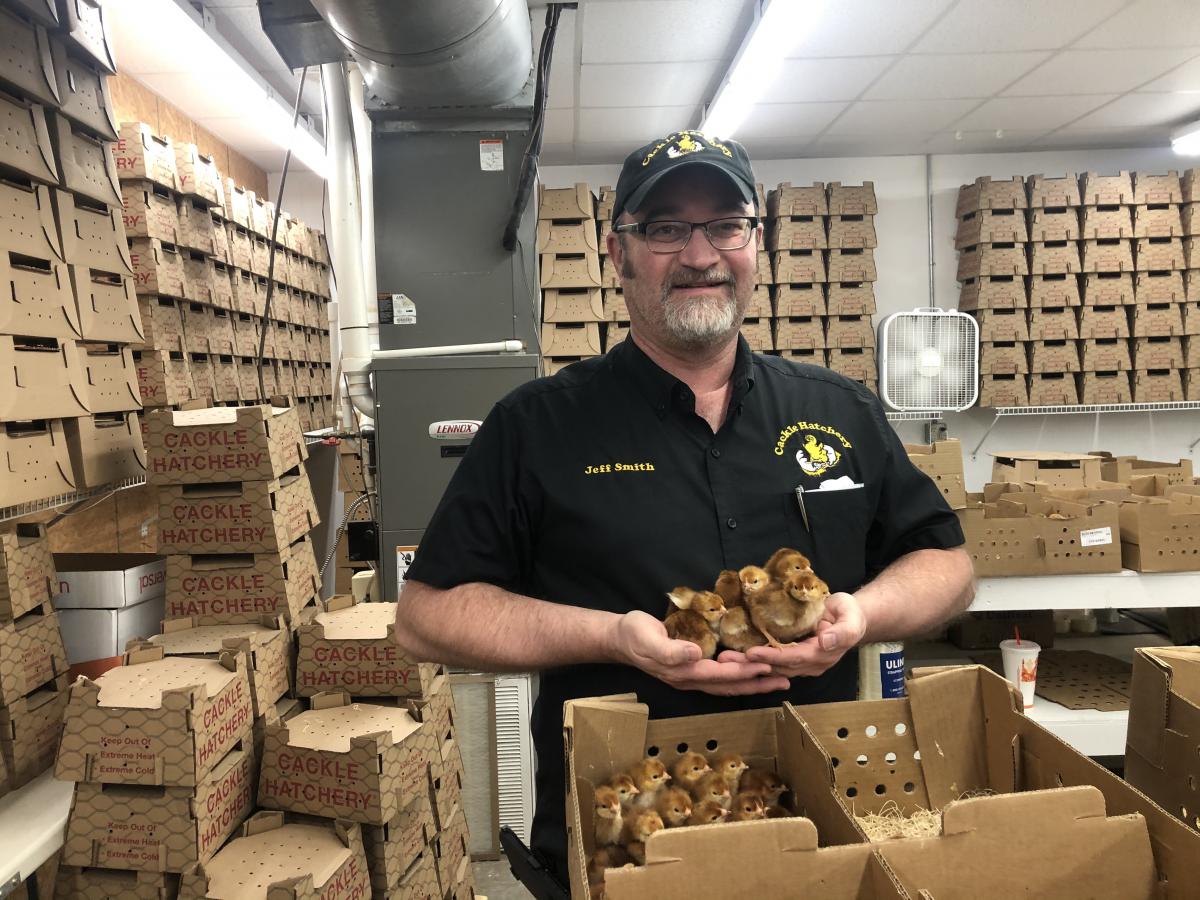
Thousands of chicks are delivered through mail at Cackle Hatchery in Lebanon, Missouri. (SETH BODINE / HARVEST PUBLIC MEDIA)
The sound of peeping, fuzzy, freshly-hatched chicks drifts through Cackle Hatchery in Lebanon, Missouri.
“We work 24/7 here, everybody is tapped out on the time and energy that they can put into it,” Smith says.
But extreme weather has made the task more challenging.
How hatcheries work
Logistics is the name of the game at Cackle Hatchery. Staff take orders months in advance. They usually have about 1 million eggs in the incubators or hatchers at all times, Smith says.
The incubators are like giant metal hens — they are set at just the right temperature and humidity, rotating the eggs so the membranes don’t stick to the shell.
“If you ever see a mama hen brooding, sitting on eggs, and she's got her head under her, kind of rolling her eggs around. That's what she's doing. She's always turning those eggs,” Smith says.
Chickens take about three weeks to hatch. Once they do hatch, employees spring into action. They determine which are hens or roosters, vaccinate them and put them in boxes ready for shipment.

Chicks in the mail
The chicks are shipped through the United States Postal Service. Smith says his grandfather also shipped eggs through the post office and by railroad when the business started in 1936.
Smith says the post office does a pretty good job for a reasonable price. Live animals are placed into a priority shipping category that typically delivers them within three days.
The anatomy of the baby birds helps them survive shipping. Dana Zook, a livestock extension specialist for Oklahoma Cooperative Extension, says when chicks are about to hatch, they absorb the yolk inside of their egg. This gives them the ability to have energy for 48 to 72 hours after they are hatched. They need to be warm, too, Zook says.
“They're not able to maintain their body temperature very well,” Zook says. “So, you know, that's the reason they like to ship quite a few chicks at a time. They kind of hold their body temperature together.”
Smith says they also have a heightened immune system that helps them weather extreme temperatures. After that, things can get dicey, which is why the hatchery relies on the speedy delivery from the USPS.

Danger in the freeze
Because of subzero temperatures in February, the USPS put an embargo on live shipments. That’s caused all sorts of headaches for Smith’s business. He’s had to find home for thousands of chicks after more than 4,000 orders were delayed.
“It's just really hard to manage because we're already, you know, taxed at our limit,” Smith says. “We just don't have automated systems in place that can manage shuffling all these orders around.”
They do the best they can to help the chicks get to their owners safely. Hatchery employees put bedding in the boxes for better insulation and absorbs moisture. But Smith says it’s hard to know what each shipping process will look like.
“We don't know specifically if they're going to be on a truck for two hours or are they going to be on a truck for 12 hours,” Smith says.
Despite the hatchery’s best efforts, they don’t always win the race. Sharodha Matlock raises and sells hundreds of chickens in Depew, Oklahoma. She wanted a separate flock for her children.
“I was like, this will give my kids something to so like they can raise their own birds,” Matlock says. “They don't have to mess with mine.”
So she placed an order from Cackle for 64 chickens in January, and received a shipment date for February. She says Cackle staff still shipped the birds because it was close to the hatchery, about a four hour drive. Only four chicks survived the trip.
“They all got cold and died. That's what happened,” Matlock says.
Those extreme conditions are why the U.S. Postal Service put a two-week embargo on live animal shipments in February 2021.
Mark Inglett, a spokesperson for the USPS, says embargoes are pretty rare. When they do happen, it’s to protect the animals.
“We don't want to put them at risk,” Inglett says. “So during circumstances like that, we won't be accepting them for mailing at those times.”
Live animal shipments are common. The Kansas City Regional Center shipped 43,614 animals between February and October of 2020.
The embargo was temporary. But for Smith, he had to figure out how to sell thousands of chicks that couldn’t be shipped. Customers lined up outside the doors of the hatchery for bargain sales, and Smith had to make countless calls to vendors to pick up chicks.
Matlock says she won’t be getting her replacement shipment of birds until June.
The USPS is not a perfect system, Smith says, but it’s one they’ve been relying on for years.
“There's always going to be problems, connection problems or weather or human error or whatnot,” Smith says. “But it's pretty amazing that you can ship something and then in two days, it's there showing up little small town in Montana or down in Key West or, you know, wherever the case might be.”













